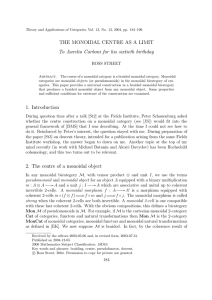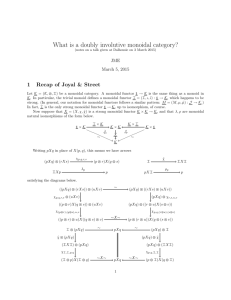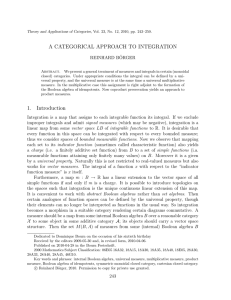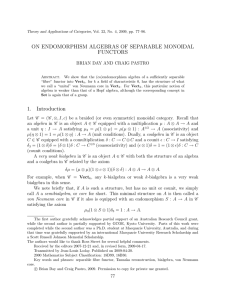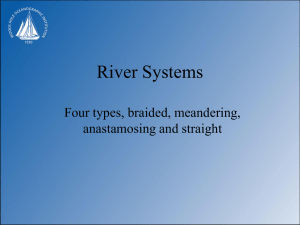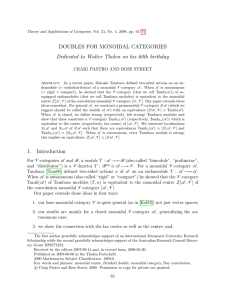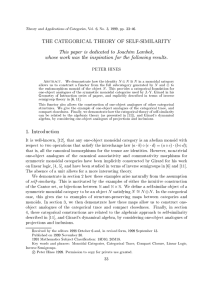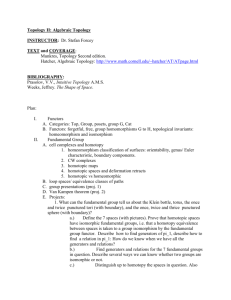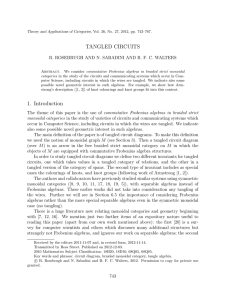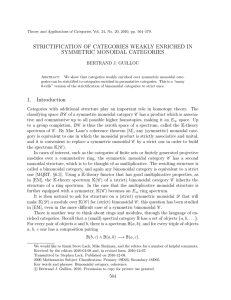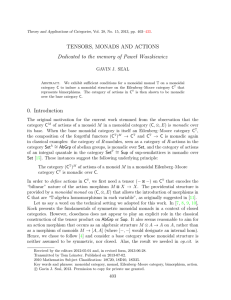WEAK BRAIDED MONOIDAL CATEGORIES AND THEIR HOMOTOPY COLIMITS MIRJAM SOLBERG
advertisement
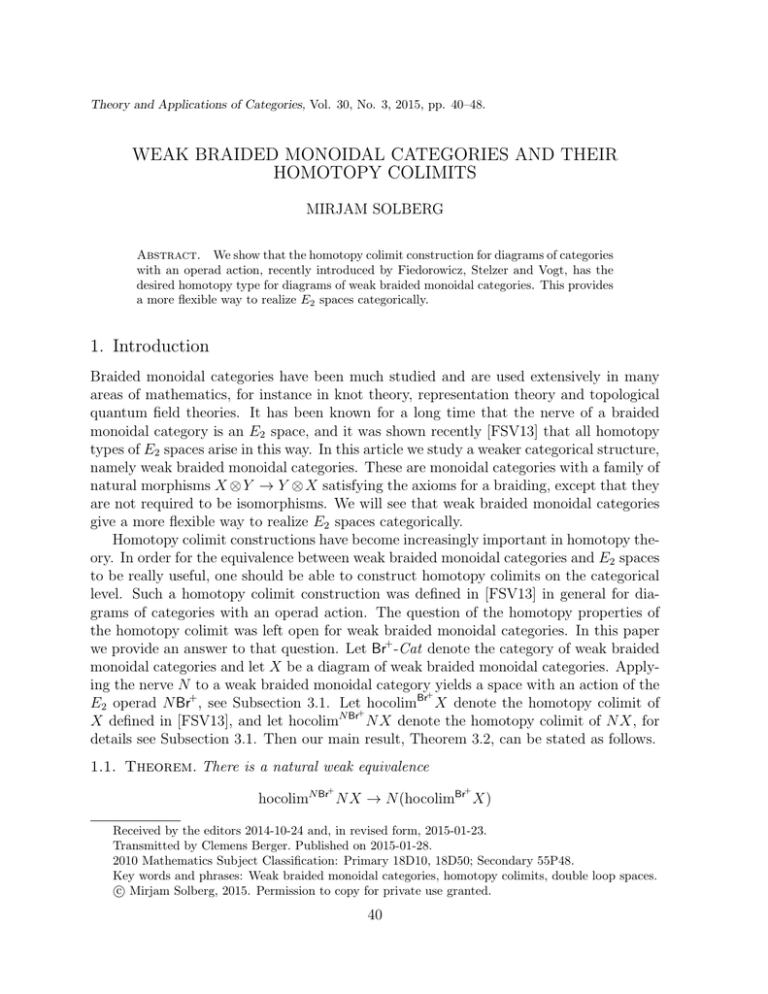
Theory and Applications of Categories, Vol. 30, No. 3, 2015, pp. 40–48. WEAK BRAIDED MONOIDAL CATEGORIES AND THEIR HOMOTOPY COLIMITS MIRJAM SOLBERG Abstract. We show that the homotopy colimit construction for diagrams of categories with an operad action, recently introduced by Fiedorowicz, Stelzer and Vogt, has the desired homotopy type for diagrams of weak braided monoidal categories. This provides a more flexible way to realize E2 spaces categorically. 1. Introduction Braided monoidal categories have been much studied and are used extensively in many areas of mathematics, for instance in knot theory, representation theory and topological quantum field theories. It has been known for a long time that the nerve of a braided monoidal category is an E2 space, and it was shown recently [FSV13] that all homotopy types of E2 spaces arise in this way. In this article we study a weaker categorical structure, namely weak braided monoidal categories. These are monoidal categories with a family of natural morphisms X ⊗ Y → Y ⊗ X satisfying the axioms for a braiding, except that they are not required to be isomorphisms. We will see that weak braided monoidal categories give a more flexible way to realize E2 spaces categorically. Homotopy colimit constructions have become increasingly important in homotopy theory. In order for the equivalence between weak braided monoidal categories and E2 spaces to be really useful, one should be able to construct homotopy colimits on the categorical level. Such a homotopy colimit construction was defined in [FSV13] in general for diagrams of categories with an operad action. The question of the homotopy properties of the homotopy colimit was left open for weak braided monoidal categories. In this paper we provide an answer to that question. Let Br+ -Cat denote the category of weak braided monoidal categories and let X be a diagram of weak braided monoidal categories. Applying the nerve N to a weak braided monoidal category yields a space with an action of the + E2 operad N Br+ , see Subsection 3.1. Let hocolimBr X denote the homotopy colimit of + X defined in [FSV13], and let hocolimN Br N X denote the homotopy colimit of N X, for details see Subsection 3.1. Then our main result, Theorem 3.2, can be stated as follows. 1.1. Theorem. There is a natural weak equivalence + + hocolimN Br N X → N (hocolimBr X) Received by the editors 2014-10-24 and, in revised form, 2015-01-23. Transmitted by Clemens Berger. Published on 2015-01-28. 2010 Mathematics Subject Classification: Primary 18D10, 18D50; Secondary 55P48. Key words and phrases: Weak braided monoidal categories, homotopy colimits, double loop spaces. c Mirjam Solberg, 2015. Permission to copy for private use granted. 40 WEAK BRAIDED MONOIDAL CATEGORIES AND THEIR HOMOTOPY COLIMITS 41 of N Br+ -algebras. 1.2. Organization. We begin by giving the definition of weak braided monoidal categories in Section 2 and provide some examples. In Section 3 we set up and prove our main result, Theorem 3.2. The proof involves an analysis of braid monoids which is interesting in its own right. 2. Weak braided monoidal categories Let D be a monoidal category with monoidal product ⊗, monoidal unit i, associativity isomorphism a and left and right unit isomorphisms l and r respectively. A weak braiding for D consists of a family of morphisms bd,e : d ⊗ e → e ⊗ d in D, natural in d and e, such that ld bd,i = rd , and rd bi,d = ld and the following two diagrams (e ⊗ D d) ⊗ f a id⊗b b⊗id (d ⊗ e) ⊗ f a e ⊗ (fC ⊗ d) a d ⊗ (e ⊗ f ) / e ⊗ (d ⊗ f ) b / (e ⊗ f ) ⊗ d d ⊗ (f ⊗ e) D a−1 / (d ⊗ f ) ⊗ e b⊗1 id⊗b d ⊗ (e ⊗ f ) a−1 (f ⊗ d) ⊗e C a−1 (d ⊗ e) ⊗ f b / f ⊗ (d ⊗ e) commute for all d, e and f in D. Here the sub indices of the weak braiding b and the associativity isomorphism a have been omitted. A weak braided monoidal category is a monoidal category equipped with a weak braiding. Note that if all the morphisms bd,e are isomorphisms, then b is a braiding for the monoidal category. 2.1. Remark. The notion of a weak braided monoidal category found in [BFSV03] and [FSV13] differs from the definition given here, in that the underlying monoidal structure is required to be strictly associative and strictly unital. This is not a significant difference, since each weak braided monoidal category is equivalent to a weak braided strict monoidal category, along monoidal functors preserving the weak braiding. The proof of this is similar to the proof of the analogous result for braided monoidal structures. Weak braided monoidal categories have not been much studied in the literature, so before we proceed we will look at some examples to show how such structures naturally arise. The first example, the disjoint union of the braid monoids, is somehow the canonical example. 42 MIRJAM SOLBERG + denote the braid monoid on m strings with the following presen2.2. Example. Let Bm tation: hσ1 , . . . , σm−1 | σi σj = σj σi if |i − j| > 1 and σi σi+1 σi = σi+1 σi σi+1 i. + The elements in Bm are called positive braids on m strings, or just positive braids. + Let B denote the category with an object m for each integer m ≥ 0, with endomor+ phisms of m the elements of the braid monoid Bm , and no other morphisms. This is a strict monoidal category with monoidal product given by m t n = m+n and juxtaposition of positive braids, the unit is 0. The weak braiding from m t n to n t m is given by the positive braid (σn · · · σm+n−1 ) · · · (σ2 · · · σm+1 )(σ1 · · · σm ), braiding the first m strings over the last n strings. This is the same as the usual braiding in the classical braid category, which is the disjoint union of the braid groups, see [JS93, Example 2.1]. 2.3. Example. We consider the category of non-negatively graded abelian groups. An object G is a collection of abelian groups Gn for n ≥ 0. A morphism f : G → H consists of group homomorphisms fn : Gn → Hn for n ≥ 0. This category has a monoidal product given by M (G ⊗ H)n = Gn1 ⊗ Hn2 . n1 +n2 =n Now fix an integer k. For g ∈ Gn1 and h ∈ Hn2 the assignment g ⊗ h 7→ k n1 n2 h ⊗ g induces a map from Gn1 ⊗ Hn2 to Hn2 ⊗ Gn1 , which in turn induces a homomorphism (G ⊗ H)n → (H ⊗ G)n . The collection of such maps gives a weak braiding for the category of non-negatively graded abelian groups. Note that if k is a unit, i.e. ±1, then the weak braiding is an actual braiding. This example may be generalized to the category of non-negatively graded R-modules for any commutative ring R. Pick an element in R to play the role of k in the weak braiding. A much studied construction is the center of a monoidal category, which can be endowed with a braided monoidal structure, see for instance Example 2.3 in [JS93]. Our next example is a weak version of this. 2.4. Example. Let D be a strict monoidal category with monoidal unit i. We consider pairs (d, δ) where d is an object in D and δ is a natural transformation δ : d⊗(−) → (−)⊗d such that δi = idd and such that for any two objects x, y ∈ D the triangle δx ⊗idy d⊗x⊗y δx⊗y ' w / x⊗y⊗d x⊗d⊗y idx ⊗δy WEAK BRAIDED MONOIDAL CATEGORIES AND THEIR HOMOTOPY COLIMITS 43 commutes. An arrow between two pairs (d, δ) → (e, ) consists of a morphism φ : d → e such that for all x ∈ D the identity x ◦ (φ ⊗ idx ) = (idx ⊗ φ) ◦ δx holds. We can define a monoidal product of two such pairs by setting (d, δ) ⊗ (e, ) = (d ⊗ e, (δ ⊗ ide ) ◦ (idd ⊗ )). The collection of morphisms δe : (d, δ) ⊗ (e, ) → (e, ) ⊗ (d, δ) satisfies the conditions for a weak braiding on this category of pairs and arrows. We call this the weak center of D. The requirement that D should be strictly associative and strictly unital was only a matter of convenience. A similar construction works for any monoidal category, details are left to the interested reader. 2.5. Operadic interpretation of weak braided monoidal structures. When the underlying monoidal multiplication is strict, weak braided monoidal categories are the algebras over a certain Cat-operad. By a Cat-operad we understand an operad internal to the category Cat of small categories. Following [FSV13, Section 8] we will introduce the Cat-operad Br+ such that Br+ -algebras are weak braided strict monoidal categories. The objects of Br+ (k) are the elements A of the symmetric group Σk . Let p : Bk+ → Σk denote the projection of the braid monoid onto the corresponding symmetric group. Then a morphism α : A → B in Br+ (k) is a positive braid α ∈ Bk+ such that p(α)A = B. Composition in Br+ (k) is given by multiplication in Bk+ . The category Br+ (k) has a right action of Σk defined on objects and morphisms by sending α : A → B to α : Ag → Bg for g ∈ Σk . The operad structure map γ : Br+ (k) × Br+ (j1 ) × · · · × Br+ (jk ) → Br+ (j1 + · · · + jk ) takes the tuple (A, B1 , . . . , Bk ) to A(j1 , . . . , jk ) ◦ (B1 t · · · t Bk ). Here A(j1 , . . . , jk ) denotes the canonical block permutation obtained from A by replacing the ith letter with ji letters. The action on morphisms is analogous except for the obvious permutation of the indices. It is easy to check that the category of weak braided monoidal categories with weak braiding preserving strict monoidal functors is isomorphic to Br+ algebras. See for instance the argument given in Section 5.1 in [SS14] for the braided monoidal version. We denote the category of Br+ -algebras by Br+ -Cat. 3. Homotopy colimits of weak braided monoidal categories In [FSV13, Definition 4.10] there is a general homotopy colimit construction for a diagram of algebras over a Cat-operad. Let L be a small category and consider the category 44 MIRJAM SOLBERG (Br+ -Cat)L of functors L → Br+ -Cat and natural transformations. The above mentioned construction gives in particular a functor + hocolimBr : (Br+ -Cat)L → Br+ -Cat. L 3.1. The homotopy type of the homotopy colimit. Let S be the category of simplicial sets and let N be the nerve functor from Cat to S. If we apply N levelwise to the Cat-operad Br+ , we get an operad N Br+ internal to the category S. We denote the category of algebras over N Br+ as N Br+ -S. A morphism of N Br+ -algebras is called a weak equivalence if the underlying simplicial set map is a weak equivalence. These are the weak equivalences in the standard model structure on N Br+ -algebras, for a reference to the topological case, see for instance [SV91, Theorem B]. Given a diagram W : L → Br+ W denote the coend construction N (−/L) ⊗L QW , where Q (N Br+ -S), let hocolimN L is an object wise cofibrant replacement functor in the category of N Br+ -algebras. This is the homotopy colimit of QW from Definition 18.1.2 in [Hir03]. If X is in (Br+ -Cat)L , then there is a natural map + + hocolimN Br N X → N (hocolimBr X), L L see the paragraph before Definition 6.7 [FSV13]. This is an operadic version of Thomason’s map in Lemma 1.2.1 [Tho79]. The question if this map is a weak equivalence or not, was left open in [FSV13]. Our main result provides a positive answer to this problem. 3.2. Theorem. The diagram (Br+ -Cat)L N / (N Br+ -S)L + + hocolimBr L Br+ -Cat N / Br hocolimN L N Br+ -S commutes up to weak equivalence of N Br+ -algebras. The operad N Br+ is an E2 operad, see Proposition 8.13 in [FSV13]. The above theorem gives one way to relate weak braided monoidal categories and E2 spaces as seen in the corollary below. Fiedorowicz, Stelzer and Vogt obtain the same equivalence without using the homotopy colimit construction of Br+ -algebras in [FSV]. 3.3. Corollary. We have an equivalence of localized categories (Br+ -Cat)[we−1 ] ' (N Br+ -S)[we−1 ]. Proof. Theorem 3.2 shows that Theorem 7.6 in [FSV13] applies to the operad Br+ . The corollary then follows from the latter theorem with the added observation that the localization (Br+ -Cat)[we−1 ] exists, see Proposition A.1 in [SS14]. WEAK BRAIDED MONOIDAL CATEGORIES AND THEIR HOMOTOPY COLIMITS 45 By general theory (details will be provided later), the proof of the theorem reduces to showing that certain categories have the property that each connected component has an initial object. Fix an A ∈ Σm , a B ∈ Σn , and non-negative integers r1 , . . . , rn such that r1 + · · · + rn = m. Let B̃ denote the canonical block permutation B(r1 , . . . , rn ) ∈ Σm obtained from B by replacing the ith letter with ri letters. We define a poset category C + depending on A, B and r1 , . . . , rn . The objects in C are the positive braids α ∈ Bm such that p(α)AB̃ ∈ (Σr1 × · · · × Σrn ) ⊆ Σm . There is a morphism α ≤ β from α to β in C if there exist γi ∈ Br+1 for i = 1, . . . , n such + that (γ1 t · · · t γn )α = β in Bm . 3.4. Analysis of minimal positive braids in C. First we note that all references to the presentation of a braid monoid, will be to the standard presentation, see Example 2.2. We call an object ν in C a minimal object if for all objects ν 0 in C, ν 0 ≤ ν implies ν 0 = ν. + Define the norm |β| ∈ N0 of an element β in Bm , as the length of any word representing β, see Section 6.5.1 in [KT08]. This is well defined because each of the relations in the presentation identifies words of equal length. It is immediate from the definition that ν is a minimal object if and only if ν 6= (γ1 t · · · t γn )ν 0 for all γi ∈ Br+i and all ν 0 ∈ C with |ν 0 | < |ν|. 3.5. Proposition. Given an object α in C there is a unique minimal object να such that να ≤ α. This proposition is the key ingredient in the proof of our main result. But before we prove either, we will derive some auxiliary results from the nature of the standard presentation of a braid monoid. Let w and w0 be two words representing the same positive braid. According to Section 6.1.5 in [KT08], w0 can be obtained from w by a finite number of consecutive substitutions of the form w1 rw2 = w1 r0 w2 where r = r0 is one of the relations in the presentation. Observe that for each of the relations r = r0 in the presentation, r and r0 contain the same letters, only the order and number of occurrences of each letter differ. This implies that a letter σi is in w if and only if σi is in w0 . + For integers r1 , . . . , rn adding up to m, consider Br+1 × · · · × Br+n as a submonoid of Bm + consisting of the positive braids in Bm which can be represented by a word not containing + the letters σri for i = 1, . . . , n − 1. The above discussion shows that α ∈ Bm lies in + + Br1 × · · · × Brn if and only if no word representing α contains any of the letters σri for + i = 1, . . . , n − 1. Also, a positive braid α ∈ Bm does not lie in Br+1 × · · · × Br+n if and only if any word representing α contains at least one of the letters σri for i = 1, . . . , n − 1. This immediately implies the next lemma. 46 MIRJAM SOLBERG + such that their product βα lies in 3.6. Lemma. Given two positive braids α and β in Bm + + + + Br1 × · · · × Brn , then both α and β lie in Br1 × · · · × Brn as well. A right common multiple of two elements x and x0 in a monoid M , is an element in M that is of the form xy = x0 y 0 for some y and y 0 in M . A right least common multiple of x and x0 is an element lcm(x, x0 ) ∈ M such that lcm(x, x0 ) is a right common multiple of x and x0 , and such that any right common multiple of x and x0 is of the form lcm(x, x0 )z for some z ∈ M . A unique right least common multiple of γ and γ 0 exists for any two positive braids γ and γ 0 on k strings, see Theorem 6.5.4 in [KT08]. Since we will only be dealing with right least common multiples, and not left least common multiples, the notation lcm will not be ambiguous. We will however use a subindex k to indicate that the least common multiple lcmk is taken in the braid monoid Bk+ . 3.7. Corollary. Given γi , γi0 ∈ Br+i for i = 1, . . . , n, let γ = γ1 t · · · t γn and similarly + of γ and γ 0 is equal γ 0 = γ10 t · · · t γn0 . Then the least common multiple lcmm (γ, γ 0 ) in Bm to lcmr1 (γ1 , γ10 ) t · · · t lcmrn (γn , γn0 ). Proof. It is clear that lcmr1 (γ1 , γ10 )t· · ·tlcmrn (γn , γn0 ) is the right least common multiple of γ and γ 0 in the monoid Br+1 × · · · × Br+n . Now lcmr1 (γ1 , γ10 ) t · · · t lcmrn (γn , γn0 ) is a right multiple of both γ and γ 0 , so we get lcmm (γ, γ 0 )φ = lcmr1 (γ1 , γ10 ) t · · · t lcmrn (γn , γn0 ) + . Since the product lcmm (γ, γ 0 )φ lies in Br+1 × · · · × Br+n , then so does for some φ ∈ Bm 0 lcmm (γ, γ ), and the result follows. Proof of Proposition 3.5. We first prove the existence of να . If α is not a minimal object, there exists an object α1 ∈ C such that α1 ≤ α and |α1 | < |α|. We repeat this process as many times as necessary until we obtain a minimal αk with αk ≤ αk−1 and |αk | < |αk−1 |. The process terminates after a finite number of steps since the norm of the αi ’s decrease strictly each time. We set να = αk , so by construction να ≤ α. We now turn to the uniqueness of να . Suppose there are two minimal objects να and να0 such that both να ≤ α and να0 ≤ α. Then α equals both (γ1 t · · · t γn )να and (γ10 t · · · t γn0 )να0 for some γi , γi0 ∈ Br+i , i = 1, . . . , n. Abbreviating γ1 t · · · t γn to γ and γ10 t · · · t γn0 to γ 0 , we recall that lcmm (γ, γ 0 ) = lcmr1 (γ1 , γ10 ) t · · · t lcmrn (γn , γn0 ). Since α is a right common multiple of both γ and γ 0 , α = (lcmr1 (γ1 , γ10 )) t · · · t (lcmrn (γn , γn0 ))ω + for some ω ∈ Bm . The right least common multiple of γi and γi0 is in particular a right common multiple of γi and γi0 , so lcm(γi , γi0 ) = γi φi = γi0 φ0i for some φi , φ0i ∈ Br+i , WEAK BRAIDED MONOIDAL CATEGORIES AND THEIR HOMOTOPY COLIMITS 47 i = 1, . . . , n. Combining this we get that (γ1 t · · · t γn )να = α = (γ1 t · · · t γn )(φ1 t · · · t φn )ω and (γ10 t · · · t γn0 )να0 = α = (γ10 t · · · t γn0 )(φ01 t · · · t φ0n )ω. The braid monoid injects into the corresponding braid group [FSV13, Theorem 6.5.4], so we can apply left cancellation to the above equations to obtain να = (φ1 t · · · t φn )ω and να0 = (φ01 t · · · t φ0n )ω. It is straightforward to check that p(ω)AB̃ is in Σr1 × · · · × Σrn , so that ω is an object in C. Then the above equations say that ω ≤ να and ω ≤ να0 in C. But since να and να0 are minimal objects these maps have to be identities. This proves the uniqueness of να . 3.8. Lemma. Each connected component in C has an initial object. Proof. Given a morphism α ≤ β in C, Proposition 3.5 associates to α and β unique minimal objects να and νβ respectively. The two objects must be equal since να ≤ α ≤ β, but νβ is the unique minimal object with νβ ≤ β. Hence the minimal objects associated to any two objects in the same connected component has to be equal, and we have a unique minimal object in each connected component of C. The minimal objects are initial in their respective connected components. Fix an M ∈ Σm , an N ∈ Σn , and non-negative integers s1 , . . . , sn such that s1 + · · · + sn = m. The factorization category C(M, N, s1 , . . . , sn ), as defined in [FSV13, Section 6], + has as objects tuples (C1 , . . . , Cn , α) consisting of Ci ∈ Σsi for i = 1, . . . n, and α ∈ Bm such that p(α)M = Ñ (C1 t · · · t Cn ). (1) A morphism from (C1 , . . . , Cn , α) to (D1 , . . . , Dn , β) consists of elements γi in Bs+i for i = 1, . . . n such that (γ1 t · · · t γn )α = β. 3.9. Lemma. The factorization category C(A, B −1 , rB −1 (1) , . . . , rB −1 (n) ) is isomorphic to the category C considered in this section. Proof. Here B̃ −1 (C1 t · · · t Cn ) = (CB(1) t · · · t CB(n) )B̃ −1 , so Equation (1) can be rewritten as p(α)AB̃ = CB(1) t · · · t CB(n) . This equation determines the Ci ’s uniquely given α with p(α)AB̃ in Σr1 × · · · × Σrn . The two categories therefore have isomorphic objects, and the morphism sets are easily seen to be isomorphic as well. Proof of Theorem 3.2. Together Lemmas 3.8 and 3.9 show that each factorization category has an initial object in each of its connected components. Thus the operad Br+ satisfies the factorization condition [FSV13, Definition 6.8] and the result follows from Theorem 6.10 [FSV13]. 48 MIRJAM SOLBERG References [BFSV03] C. Balteanu, Z. Fiedorowicz, R. Schwänzl, and R. Vogt. Iterated monoidal categories. Adv. Math., 176(2):277–349, 2003. [FSV] Z. Fiedorowicz, M. Stelzer, and R. M. Vogt. Rectification of weak product algebras over an operad in Cat and Top and applications. arXiv:1311.2817. [FSV13] Z. Fiedorowicz, M. Stelzer, and R. M. Vogt. Homotopy colimits of algebras over Cat-operads and iterated loop spaces. Adv. Math., 248:1089–1155, 2013. [Hir03] Philip S. Hirschhorn. Model categories and their localizations, volume 99 of Mathematical Surveys and Monographs. American Mathematical Society, Providence, RI, 2003. [JS93] André Joyal and Ross Street. Braided tensor categories. Adv. Math., 102(1):20– 78, 1993. [KT08] Christian Kassel and Vladimir Turaev. Braid groups, volume 247 of Graduate Texts in Mathematics. Springer, New York, 2008. [SS14] C. Schlichtkrull and M. Solberg. Braided injections and double loop spaces. Accepted for publication in Trans. Amer. Math. Soc. Available at arXiv:1403.1101, 2014. [SV91] R. Schwänzl and R. M. Vogt. The categories of A∞ - and E∞ -monoids and ring spaces as closed simplicial and topological model categories. Arch. Math. (Basel), 56(4):405–411, 1991. [Tho79] R. W. Thomason. Homotopy colimits in the category of small categories. Math. Proc. Cambridge Philos. Soc., 85(1):91–109, 1979. Department of Mathematics, University of Bergen, P.O. Box 7800, N-5020 Bergen, Norway Email: mirjam.solberg@math.uib.no This article may be accessed at http://www.tac.mta.ca/tac/ THEORY AND APPLICATIONS OF CATEGORIES (ISSN 1201-561X) will disseminate articles that significantly advance the study of categorical algebra or methods, or that make significant new contributions to mathematical science using categorical methods. The scope of the journal includes: all areas of pure category theory, including higher dimensional categories; applications of category theory to algebra, geometry and topology and other areas of mathematics; applications of category theory to computer science, physics and other mathematical sciences; contributions to scientific knowledge that make use of categorical methods. Articles appearing in the journal have been carefully and critically refereed under the responsibility of members of the Editorial Board. Only papers judged to be both significant and excellent are accepted for publication. Full text of the journal is freely available in .dvi, Postscript and PDF from the journal’s server at http://www.tac.mta.ca/tac/ and by ftp. It is archived electronically and in printed paper format. Subscription information Individual subscribers receive abstracts of articles by e-mail as they are published. To subscribe, send e-mail to tac@mta.ca including a full name and postal address. For institutional subscription, send enquiries to the Managing Editor, Robert Rosebrugh, rrosebrugh@mta.ca. The typesetting language of the journal is TEX, and LATEX2e strongly encouraged. Articles should be submitted by e-mail directly to a Transmitting Editor. Please obtain detailed information on submission format and style files at http://www.tac.mta.ca/tac/. Information for authors Managing editor. Robert Rosebrugh, Mount Allison University: rrosebrugh@mta.ca TEXnical editor. Michael Barr, McGill University: barr@math.mcgill.ca Assistant TEX editor. Gavin Seal, Ecole Polytechnique Fédérale de Lausanne: gavin seal@fastmail.fm Transmitting editors. Clemens Berger, Université de Nice-Sophia Antipolis: cberger@math.unice.fr Richard Blute, Université d’ Ottawa: rblute@uottawa.ca Lawrence Breen, Université de Paris 13: breen@math.univ-paris13.fr Ronald Brown, University of North Wales: ronnie.profbrown(at)btinternet.com Valeria de Paiva: valeria.depaiva@gmail.com Ezra Getzler, Northwestern University: getzler(at)northwestern(dot)edu Kathryn Hess, Ecole Polytechnique Fédérale de Lausanne: kathryn.hess@epfl.ch Martin Hyland, University of Cambridge: M.Hyland@dpmms.cam.ac.uk Anders Kock, University of Aarhus: kock@imf.au.dk Stephen Lack, Macquarie University: steve.lack@mq.edu.au F. William Lawvere, State University of New York at Buffalo: wlawvere@buffalo.edu Tom Leinster, University of Edinburgh: Tom.Leinster@ed.ac.uk Ieke Moerdijk, Radboud University Nijmegen: i.moerdijk@math.ru.nl Susan Niefield, Union College: niefiels@union.edu Robert Paré, Dalhousie University: pare@mathstat.dal.ca Jiri Rosicky, Masaryk University: rosicky@math.muni.cz Giuseppe Rosolini, Università di Genova: rosolini@disi.unige.it Alex Simpson, University of Edinburgh: Alex.Simpson@ed.ac.uk James Stasheff, University of North Carolina: jds@math.upenn.edu Ross Street, Macquarie University: street@math.mq.edu.au Walter Tholen, York University: tholen@mathstat.yorku.ca Myles Tierney, Rutgers University: tierney@math.rutgers.edu Robert F. C. Walters, University of Insubria: rfcwalters@gmail.com R. J. Wood, Dalhousie University: rjwood@mathstat.dal.ca
